Electronic and Optical Properties of Polythiophene Molecules and Derivatives
Abstract
:1. Introduction
2. Theoretical Calculations, Principles, and Methods
3. Simulation Methods
3.1. PT Polymers
3.2. PT Derivatives
3.3. Simulation
3.4. Exchange–Correlation Functional and Basis Sets Used in Calculation
3.5. Experimental Setup for Cyclic Voltammetry, UV/Vis Spectrum, PL Spectrum and UPS Spectrum
4. Discussion
4.1. Exchange Functional and Basis Sets Used for Optimization and LUMO and HOMO Energy Levels of PT Polymers
4.2. Optimized Molecular Structures and Orbital Diagrams of T2, T4, T10, and T20
4.3. Work Function, Valance Band Maximum, Conduction Band Minimum, and Band Gap of T6 (α-Sexithiophene)
4.4. Redox Potential, UV/Vis Spectrum, and PL Spectrum of T2 (2,2-Bithiophene)
4.5. Free Energy, Electron Affinity, and Electron/Hole Reorganization Energy
4.6. Structural Optimization for PT Derivatives
4.7. Energy Levels and Band Gaps of PT Derivatives
4.8. Wavelengths of Absorption and Emission Peaks, Band Gaps, and Oscillation Strengths of PT Derivatives
4.9. Free Energy (IP), Electron Affinity (EA), and Electron and Hole Reorganization Energy (λh, λe) of PT Derivatives
5. Conclusions
Author Contributions
Funding
Acknowledgments
Conflicts of Interest
References
- Burroughes, J.H.; Bradley, D.D.C.; Brown, A.R.; Marks, R.N.; Mackay, K.; Friend, R.H.; Burns, P.L.; Holmes, A.B. Light-emitting diodes based on conjugated polymers. Nature 1990, 347, 539–541. [Google Scholar] [CrossRef]
- Andersson, M.R.; Berggren, M.; Gustafsson, G.; Gustafsson-Carlberg, J.C.; Selse, D.; Hjertberg, T.; Wennerstroem, O. Electroluminescence from substituted poly(thiophenes): From blue to near-infrared. Macromolecules 1995, 27, 7525–7529. [Google Scholar] [CrossRef]
- van Mullekoma, H.A.M.; Vekemans, J.A.J.M.; Havinga, E.E.; Meijer, E.W. Developments in the chemistry and band gap engineering of donor–acceptor substituted conjugated polymers. Mater. Sci. Eng. 2001, 32, 1–40. [Google Scholar] [CrossRef]
- Colditz, R.; Grebner, D.; Helbig, M.; Rentsch, S. Theoretical studies and spectroscopic investigations of ground and excited electronic states of thiophene oligomers. Chem. Phys. 1995, 201, 309–320. [Google Scholar] [CrossRef]
- Ferro, D.R.; Porzio, W.; Destri, S.; Ragaui, M.; Brückner, S. Application of molecular mechanics to refine and understand the crystal structure of polythiophene and its oligomers. Macromol. Theory Simul. 1997, 6, 713–727. [Google Scholar] [CrossRef]
- Ma, J.; Li, S.; Jiang, Y. A time-dependent DFT study on band gaps and effective conjugation lengths of polyacetylene, polyphenylene, polypentafulvene, polycyclopentadiene, polypyrrole, polyfuran, polysilole, polyphosphole and polythiophene. Macromolecules 2002, 35, 1109–1115. [Google Scholar] [CrossRef]
- Colle, R.; Grosso, G.; Ronzani, A.; Zicovich-Wilson, C.M. Structure and X-ray spectrum of crystalline poly(3-hexylthiophene) from DFT-van der Waals calculations. Phys. Status Solidi B 2011, 248, 1360–1368. [Google Scholar] [CrossRef]
- Bella, A.; Panneerselvam, M.; Vedha, S.A.; Jaccob, M.; Solomon, R.V.; Merlin, J.P. DFT-TDDFT framework of diphenylamine based mixed valence compounds for optoelectronic applications—Structural modification of π acceptors. Comput. Mater. Sci. 2019, 162, 359–369. [Google Scholar] [CrossRef]
- Taouali, W.; Casida, M.E.; Darghouth, A.A.M.H.M.; Alimia, K. Theoretical design of new small molecules with a low band-gap for organic solar cell applications: DFT and TD-DFT study. Comput. Mater. Sci. 2018, 150, 54–61. [Google Scholar] [CrossRef]
- Solomon, R.V.; Jagadeesan, R.; Vedha, S.A.; Venuvanalingam, P. A DFT/TDDFT modelling of bithiopheneazochromophores for optoelectronic applications. Dye. Pigment. 2014, 100, 261–268. [Google Scholar] [CrossRef]
- Panneerselvam, M.; Kathiravan, A.; Solomon, R.V.; Jaccob, M. The role of π-linkers in tuning the optoelectronic properties of triphenylamine derivatives for solar cell applications—A DFT/TDDFT study. Phys. Chem. Chem. Phys. 2017, 19, 6153–6163. [Google Scholar] [CrossRef] [PubMed]
- Song, M.X.; He, K.C.; Lü, P.; Wang, L.J.; Cao, Y.Q.; Song, S.Y.; Meng, X.W.; Lü, S.Q.; Qin, Z.K.; Bai, F.Q.; et al. DFT and TD-DFT study a series of blue and green iridium complexes with mesityl-phenyl-imidazole ligand. Org. Electron. 2019, 64, 181–187. [Google Scholar] [CrossRef]
- Nayak, P.K.; Periasamy, N. Calculation of electron affinity, ionization potential, transport gap, optical band gap and exciton binding energy of organic solids using ‘solvation’ model and DFT. Org. Electron. 2009, 10, 1396–1400. [Google Scholar] [CrossRef]
- Kuusik, I.; Kook, M.; Pärna, R.; Kivimäki, A.; Käämbre, T.; Reisberg, L.; Kikas, A.; Kisand, V. The electronic structure of ionic liquids based on the TFSI anion: A gas phase UPS and DFT study. J. Mol. Liq. 2019, 294, 111580. [Google Scholar] [CrossRef]
- Quites, F.J.; Faria, G.C.; Germino, J.C.; Atvars, T.D.Z. Tuning emission colors from blue to green in polymeric light-emitting diodes fabricated using polyfluorene blends. J. Phys. Chem. A 2014, 118, 10380–10390. [Google Scholar] [CrossRef]
- Chen, R.; Wang, Y.; Chen, T.; Li, H.; Zheng, C.; Yuan, K.; Wang, Z.; Tao, Y.; Zheng, C.; Huang, W. Heteroatom-bridged benzothiazolyls for organic solar cells: A theoretical study. J. Phys. Chem. B 2015, 119, 583–591. [Google Scholar] [CrossRef] [PubMed]
- Kuusik, I.; Berholts, M.; Kruusma, J.; Kisand, V.; Tõnisoo, A.; Lust, E.; Nõmmiste, E. Valence electronic structure of [EMIM][BF4] ionic liquid: Photoemission and DFT+D study. RSC Adv. 2018, 8, 30298–30304. [Google Scholar] [CrossRef] [Green Version]
- Kuusik, I.; Kook, M.; Pärna, R.; Kisand, V. Ionic liquid vapors in vacuum: Possibility to derive anodic stabilities from DFT and UPS. ACS Omega 2021, 6, 5255–5265. [Google Scholar] [CrossRef]
- Alguno, A.C.; Chung, W.C.; Bantaculo, R.V.; Vequizo, R.M.; Miyata, H.; Ignacio, E.W.; Bacal, A.M. Ab initio and density functional studies of polythiophene energy band gap. NECTEC Tech. J. 2001, 2, 215–218. Available online: http://citeseerx.ist.psu.edu/viewdoc/download?doi=10.1.1.510.5901&rep=rep1&type=pdf (accessed on 12 August 2021).
- Mori, K.; Matsumoto, N.; Nomoto, S.; Tsuruta, K. Computational and experimental analyses of detachment force at the interface between carbon fibers and epoxy resin. Open J. Compos. Mater. 2017, 7, 179–184. [Google Scholar] [CrossRef] [Green Version]
- Becke, A.D. Density-functional thermochemistry. III. The role of exact exchange. J. Chem. Phys. 1993, 98, 5648. [Google Scholar] [CrossRef] [Green Version]
- Stephens, P.J.; Devlin, J.F.; Chabalowski, C.F.; Frisch, M.J. Ab initio calculation of vibrational absorption and circular dichroism spectra using density functional force fields. J. Chem. Phys. 1993, 98, 11623–11627. [Google Scholar] [CrossRef]
- Kobayashi, M.; Chen, J.; Chung, T.C.; Moraes, F.; Heeger, A.J.; Wudl, F. Synthesis and properties of chemically coupled poly(thiophene). Synth. Met. 1984, 9, 77–86. [Google Scholar] [CrossRef]
- Schulz, P.; Edri, E.; Kirmayer, S.; Hodes, G.; Cahen, D.; Kahn, A. Interface energetics in organo-metal halide perovskite-based photovoltaic cells. Energy Environ. 2014, 7, 1377–1381. [Google Scholar] [CrossRef]
- Lete, C.; Gadgil, B.; Kvarnström, C. The electrochemistry of copolymer films based on azulene and 3 thiophene acetic acid. J. Electroanal. Chem. 2015, 742, 30–36. [Google Scholar] [CrossRef]
- Bagger, A.; Arán-Ais, R.M.; Stenlid, J.H.; Santos, E.C.D.; Arnarson, L.; Jensen, K.D.; Escudero-Escribano, M.; Cuenya, B.R.; Rossmeisl, J. Ab initio cyclic voltammetry on Cu(111), Cu(100) and Cu(110) in acidic, neutral and alkaline solutions. ChemPhysChem 2019, 20, 3096–3105. [Google Scholar] [CrossRef]
- Rossmeisl, J.; Jensen, K.D.; Petersen, A.S.; Arnarson, L.; Bagger, A.; Escudero-Escribano, M. Realistic cyclic voltammograms from ab initio simulations in alkaline and acidic electrolytes. J. Phys. Chem. C 2020, 124, 20055–20065. [Google Scholar] [CrossRef]
- Tiwari, A.; Heenen, H.H.; Bjørnlund, A.S.; Maagaard, T.; Cho, E.; Chorkendorff, I.; Kristoffersen, H.H.; Chan, K.; Horch, S. Fingerprint voltammograms of copper single crystals under alkaline conditions: A fundamental mechanistic analysis. J. Phys. Chem. Lett. 2020, 11, 1450–1455. [Google Scholar] [CrossRef]
- Bruix, A.; Margraf, J.T.; Andersen, M.; Reuter, K. First-principles-based multiscale modelling of heterogeneous catalysis. Nat. Catal. 2019, 2, 659–670. [Google Scholar] [CrossRef]
- Pedersen, J.K.; Batchelor, T.A.A.; Bagger, A.; Rossmeisl, A. High-entropy alloys as catalysts for the CO2 and CO Reduction Reactions. ACS Catal. 2020, 10, 2169–2176. [Google Scholar] [CrossRef]
- Elgrishi, N.; Rountree, K.J.; McCarthy, B.D.; Rountree, E.S.; Eisenhart, T.T.; Dempsey, J.L. A practical beginner’s guide to cyclic voltammetry. J. Chem. Educ. 2018, 95, 197–206. [Google Scholar] [CrossRef]
- Changsuk, Y.; Seongpil, H. Analysis of the charging current in cyclic voltammetry and supercapacitor’s galvanostatic charging profile based on a constant-phase element. ACS Omega 2021, 6, 367–373. [Google Scholar] [CrossRef]
- Kim, Y.N.; Yun, D.Y.; Arul, N.S.; Kim, T.W. Carrier transport mechanisms of multilevel non-volatile memory devices with a floating gate consisting of hybrid organic/inorganic nano composites. Org. Electron. 2015, 17, 270–274. [Google Scholar] [CrossRef]
- Bredas, J.L.; Silbey, R.; Boudreaux, D.S.; Chance, R.R. Chain-length dependence of electronic and electrochemical properties of conjugated systems: Polyacetylene, polyphenylene, polythiophene, and polypyrrole. J. Am. Chem. Soc. 1983, 105, 6555–6559. [Google Scholar] [CrossRef]
- Marcus, R.A. On the theory of oxidation-reduction reactions involving electron transfer. J. Chem. Phys. 1956, 24, 966. [Google Scholar] [CrossRef] [Green Version]

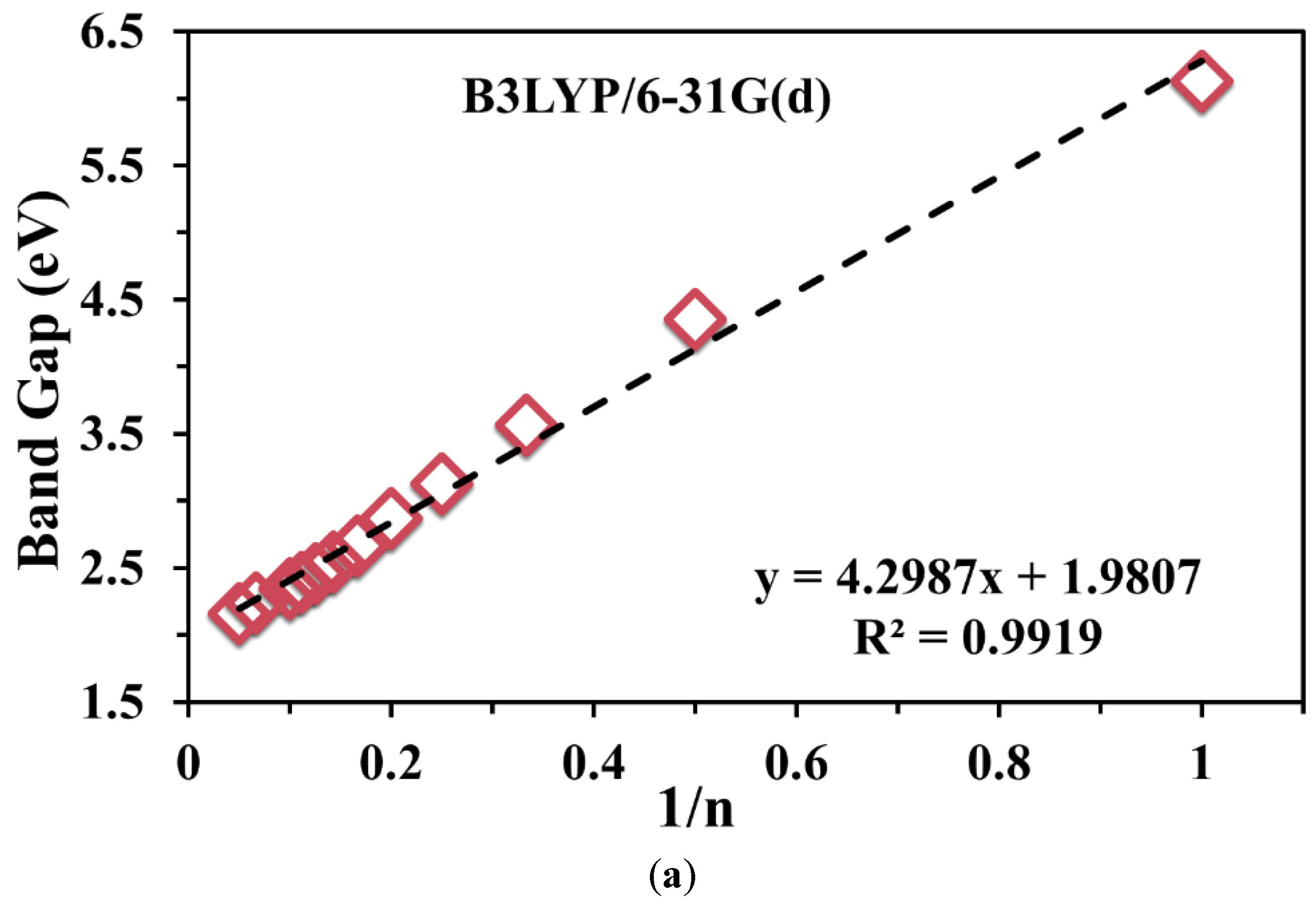
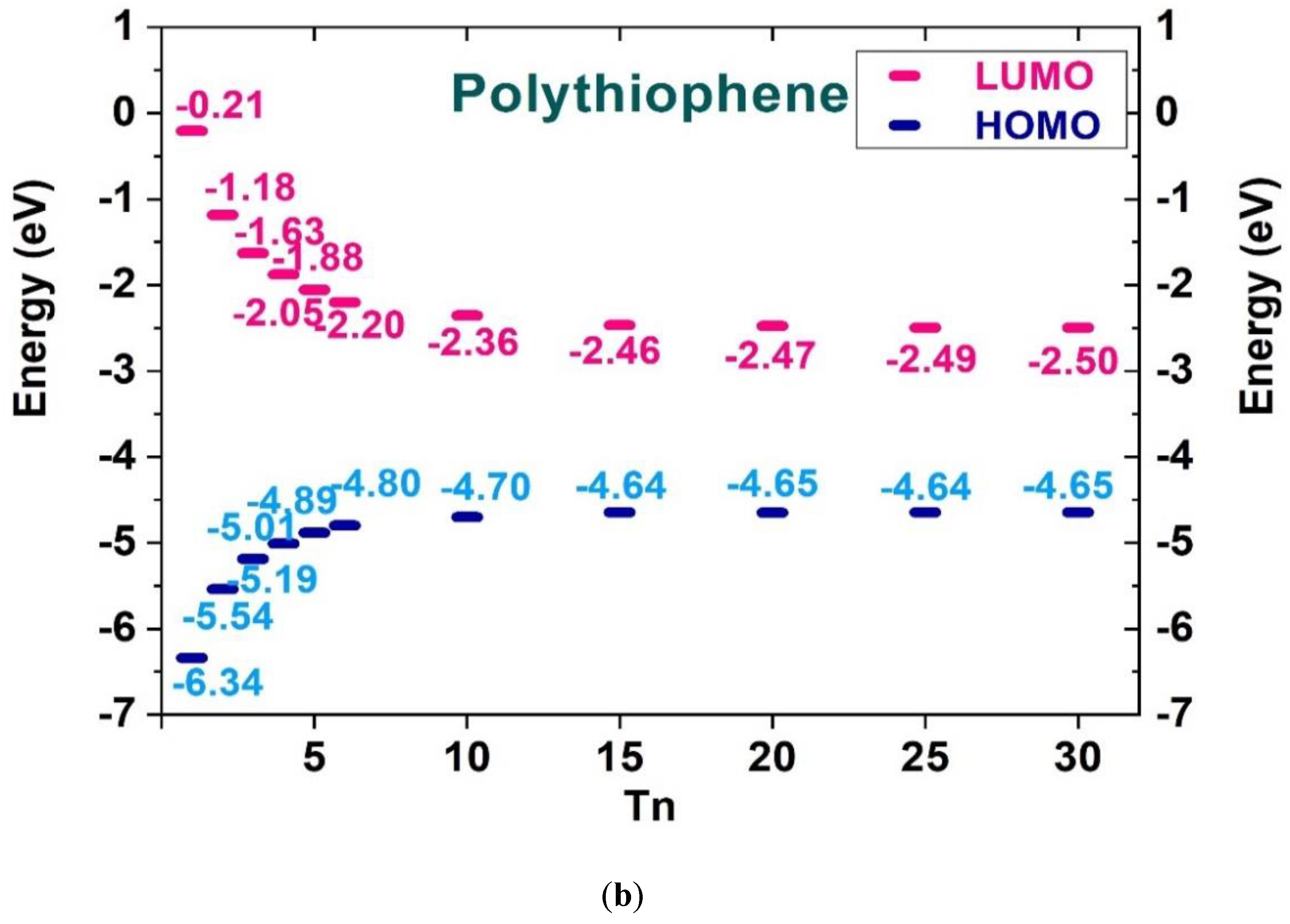

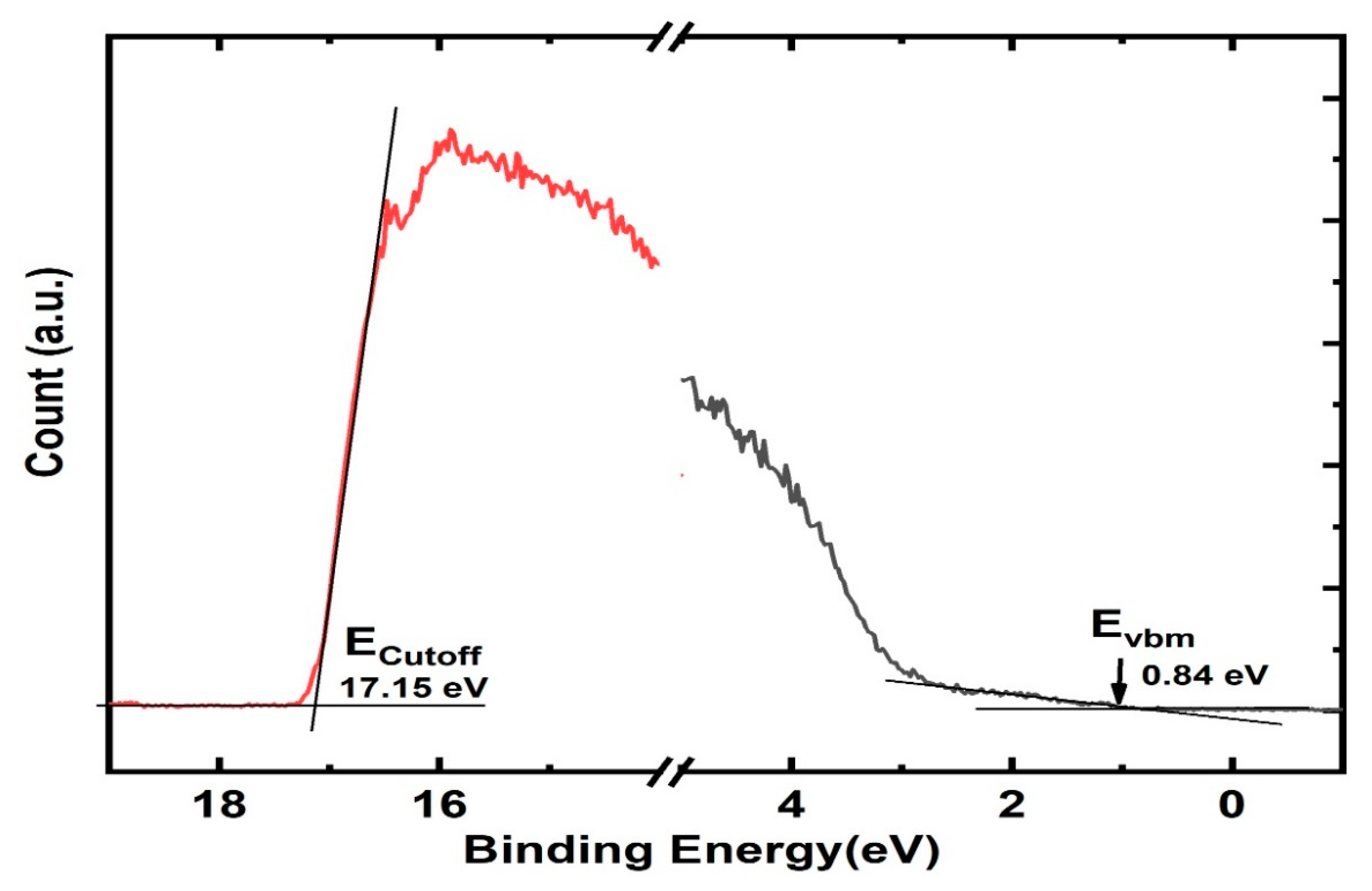
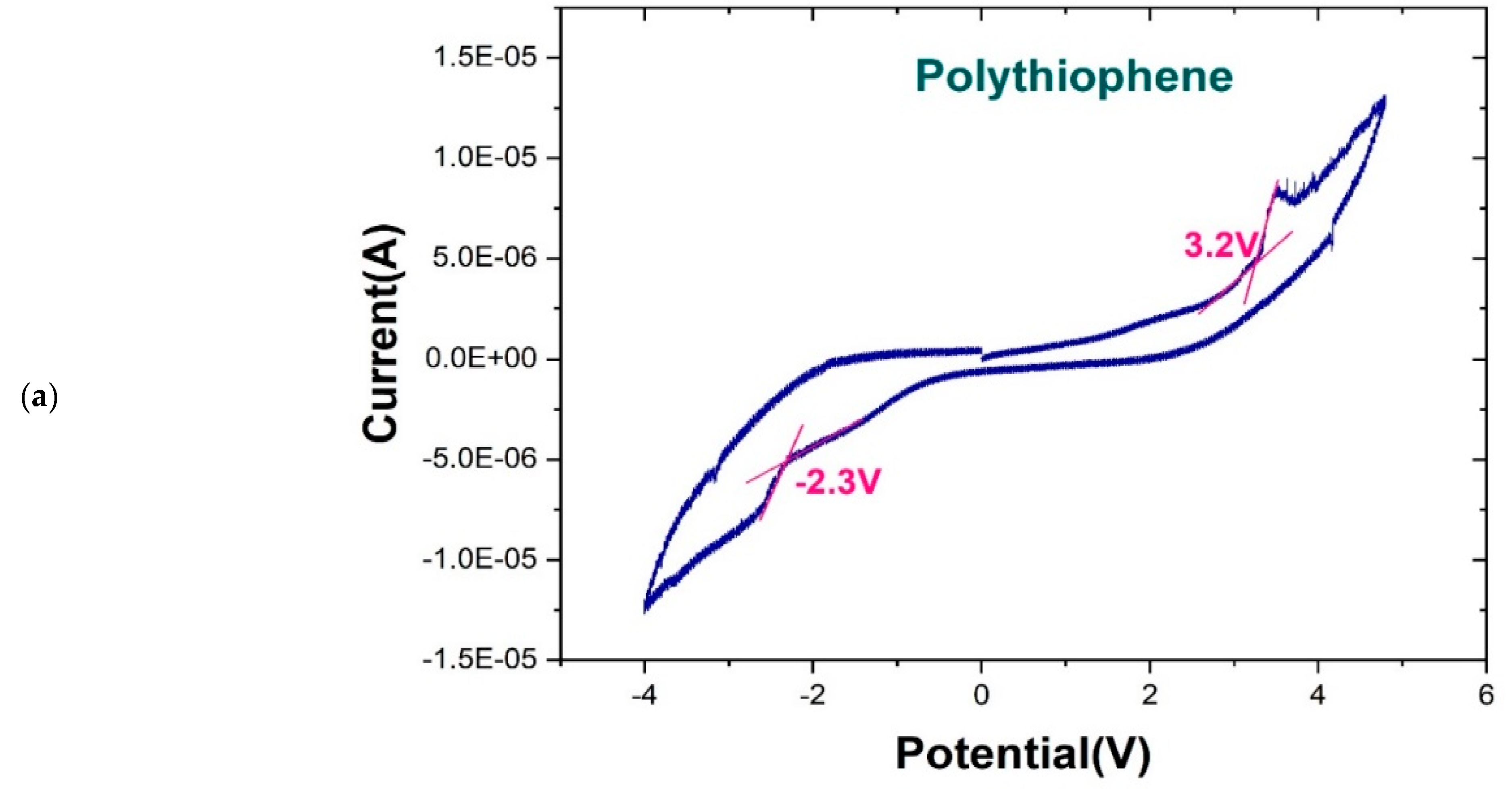
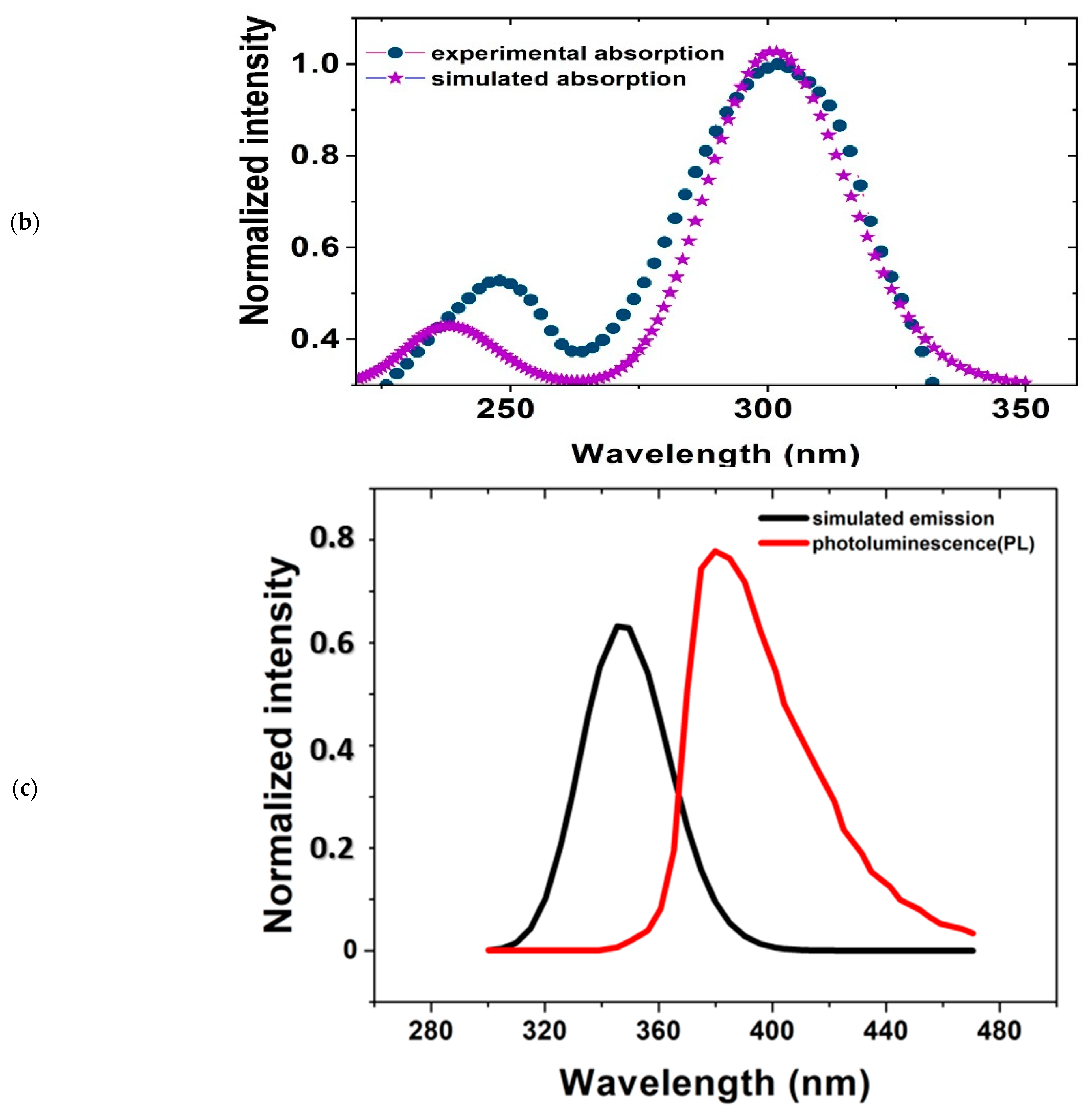

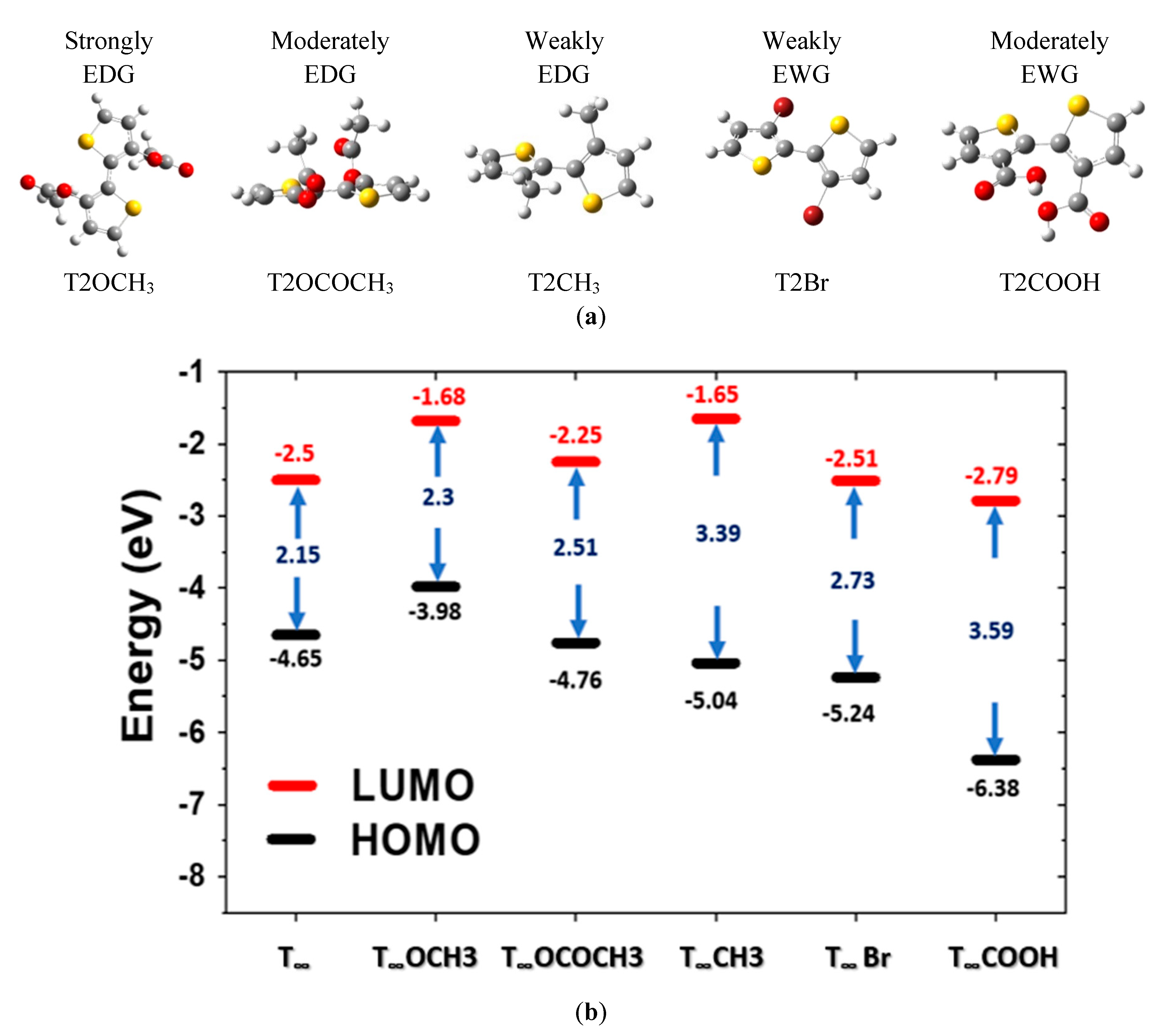
| Polymers | Objectives | Job | Method and Exchange-Correlation Functional | Basis Set | |
|---|---|---|---|---|---|
| T1–T10, T15,T20 T25,T30 | 1. Optimization 2. Band Gap 3.Linear Extrapolation => PT Band Gap | Opt + freq | DFT | B3LYP | 6-31G(d) |
| 6-311G(d) | |||||
| CEP-31G(d) | |||||
| T1–T10, T15,T20 T25,T30 | 1.Electronic Properties 2.UV/Vis Spectrum | Energy | TD-DFT | B3LYP | 6-31G(d) |
| Polymers | Objectives | Job | Method and Exchange-Correlation Functional | BASIS SET | |
|---|---|---|---|---|---|
| T1–T10, T15,T20, T25,T30 | Excited State Optimization | Opt + freq | CIS | 6-31G(d) | |
| Emission Spectrum | Energy | TD-DFT | B3LYP | ||
| Exchange-Correlation Functional Used in the Calculation | |||
|---|---|---|---|
| B3LYP/6-31G(d) | B3LYP/6-311G(d) | B3LYP/CEP-31G(d) | |
| Calculated band gap (eV) | 1.9807 | 2.2058 | 1.8654 |
| Literature experimental data | 2.00 eV | ||
| Error (%) | −0.965 | 10.29 | −6.73 |
| Derivatives of PT Polymer | IP | EA | λh | λe |
|---|---|---|---|---|
| T∞ | 5.1 | −2.1 | 0.18 | 0.15 |
| T∞OCH3 | 4.36 | −1.6 | 0.22 | 0.02 |
| T∞OCOCH3 | 5.77 | −2.47 | 0.25 | 0.35 |
| T∞CH3 | 5.42 | −1.46 | 0.71 | 0.36 |
| T∞Br | 5.5 | −2.4 | 0.07 | 0.08 |
| T∞COOH | 8.23 | −3.11 | 0.2 | 0.23 |
| Derivatives of PT Polymer | Peak Wavelength (nm) | E (eV) | Osc. Strength (f) | Major Contribution |
|---|---|---|---|---|
| T2OCH3 | 327.60 | 3.79 | 0.43 | LUMO (99%) |
| T4OCH3 | 471.92 | 2.63 | 1.18 | LUMO (100%) |
| T6OCH3 | 582.85 | 2.13 | 2.05 | LUMO (100%) |
| T2OCOCH3 | 307.76 | 4.03 | 0.39 | LUMO (99%) |
| T4OCOCH3 | 430.27 | 2.88 | 1.09 | LUMO (100%) |
| T6OCOCH3 | 505.97 | 2.45 | 1.82 | LUMO (99%) |
| T2CH3 | 266.34 | 4.66 | 0.19 | LUMO (92%) |
| T4CH3 | 359.89 | 3.45 | 0.89 | LUMO (98%) |
| T6CH3 | 412.62 | 3.01 | 1.43 | LUMO (99%) |
| T2Br | 299.38 | 4.15 | 0.25 | LUMO (97%) |
| T4Br | 430.14 | 2.89 | 1.08 | LUMO (100%) |
| T6Br | 506.14 | 2.45 | 1.82 | LUMO (100%) |
| T2COOH | 318.32 | 3.90 | 0.20 | LUMO (97%) |
| T4COOH | 332.57 | 3.73 | 0.73 | LUMO (98%) |
| T6COOH | 356.47 | 3.48 | 0.53 | LUMO (92%) |
| 340.81 | 3.64 | 1.04 | H-1 L+1 (92%) |
| Emission | Wavelength (nm) | E (eV) | Osc. Strength (f) |
|---|---|---|---|
| T2OCH3 | 360.14 | 3.45 | 0.45 |
| T4OCH3 | 515.14 | 2.41 | 1.24 |
| T6OCH3 | 610.54 | 2.03 | 2.12 |
| T2OCOCH3 | 345.62 | 3.59 | 0.40 |
| T4OCOCH3 | 479.98 | 2.59 | 1.19 |
| T6OCOCH3 | 534.13 | 2.32 | 1.62 |
| T2CH3 | 354.57 | 3.50 | 0.37 |
| T4CH3 | 458.45 | 2.71 | 1.15 |
| T6CH3 | 494.82 | 2.51 | 1.74 |
| T2Br | 380.28 | 3.26 | 0.29 |
| T4Br | 469.51 | 2.64 | 1.09 |
| T6Br | 506.59 | 2.45 | 1.63 |
| T2COOH | 415.87 | 2.98 | 0.27 |
| T4COOH | 490.56 | 2.53 | 0.63 |
| T6COOH | 506.80 | 2.45 | 1.25 |
Publisher’s Note: MDPI stays neutral with regard to jurisdictional claims in published maps and institutional affiliations. |
© 2021 by the authors. Licensee MDPI, Basel, Switzerland. This article is an open access article distributed under the terms and conditions of the Creative Commons Attribution (CC BY) license (https://creativecommons.org/licenses/by/4.0/).
Share and Cite
Tsai, H.-W.; Hsueh, K.-L.; Chen, M.-H.; Hong, C.-W. Electronic and Optical Properties of Polythiophene Molecules and Derivatives. Crystals 2021, 11, 1292. https://doi.org/10.3390/cryst11111292
Tsai H-W, Hsueh K-L, Chen M-H, Hong C-W. Electronic and Optical Properties of Polythiophene Molecules and Derivatives. Crystals. 2021; 11(11):1292. https://doi.org/10.3390/cryst11111292
Chicago/Turabian StyleTsai, Huai-Wen, Kan-Lin Hsueh, Mei-Hsin Chen, and Che-Wun Hong. 2021. "Electronic and Optical Properties of Polythiophene Molecules and Derivatives" Crystals 11, no. 11: 1292. https://doi.org/10.3390/cryst11111292
APA StyleTsai, H.-W., Hsueh, K.-L., Chen, M.-H., & Hong, C.-W. (2021). Electronic and Optical Properties of Polythiophene Molecules and Derivatives. Crystals, 11(11), 1292. https://doi.org/10.3390/cryst11111292





